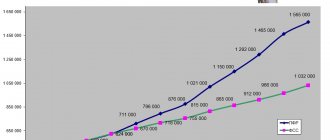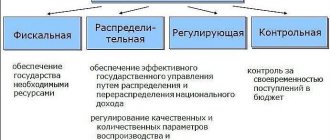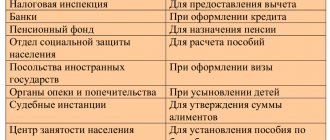Purpose of tax control
The purpose of tax control is to prevent and identify tax offenses (including tax crimes), as well as to bring to justice persons who have violated tax laws.
The goals of tax control are realized by solving certain tasks:
- ensuring the economic security of the state during the formation of public centralized and decentralized monetary funds;
- ensuring proper control over the formation of state revenues and their rational use;
- improving interaction and coordination of the activities of control bodies in the Russian Federation;
- checking the fulfillment of financial obligations to the state and municipalities by organizations and individuals;
- checking the intended use of tax benefits;
- suppression and prevention of offenses in the tax sphere.
On-site tax audits
According to Article 89 of the Tax Code of the Russian Federation, tax authorities do not have the right to conduct two or more on-site tax audits on the same taxes for the same period. Tax authorities do not have the right to conduct more than two on-site tax audits in relation to one taxpayer during a calendar year, except in cases where the head of the Federal Tax Service of Russia makes a decision on the need to conduct an on-site tax audit of the taxpayer in excess of the specified limit.
The concept of the planning system for on-site tax audits defines the criteria for tax risks, according to which, as a result of analytical work, tax authorities select taxpayers for inclusion in the plan for on-site tax audits. The risk criteria are publicly available, posted on the website of the Federal Tax Service of Russia and are regularly updated.
These are the current criteria:
1. The tax burden of a given taxpayer is below its average level for business entities in a particular industry;
2. Reflection in accounting or tax reporting of losses over several tax periods;
3. Reflection in tax reporting of significant amounts of tax deductions for a certain period;
4. Outpacing growth rate of expenses over the growth rate of income from the sale of goods (works, services);
5. Payment of average monthly wages per employee below the average level for the type of economic activity in the constituent entity of the Russian Federation;
6. Repeatedly approaching the maximum value of the indicators established by the Tax Code of the Russian Federation that grant taxpayers the right to apply special tax regimes;
7. Reflection by an individual entrepreneur of the amount of expenses as close as possible to the amount of his income received for the calendar year;
8. Construction of financial and economic activities based on concluding agreements with counterparties-resellers or intermediaries (“chains of counterparties”) without reasonable economic or other reasons (business purpose);
9. Failure by the taxpayer to provide explanations to the notification of the tax authority about the identification of discrepancies in performance indicators, and (or) failure to provide the tax authority with the requested documents, and (or) the availability of information about their destruction, damage, etc.;
10. Repeated deregistration and registration with the tax authorities of the taxpayer in connection with a change in location (“migration” between tax authorities).
Thus, the planning system for on-site tax audits, which is available to every taxpayer, allows the taxpayer to independently assess their tax risks and clarify tax obligations without waiting for an on-site tax audit.
It must be borne in mind that tax authorities, in accordance with Article 31 of the Tax Code of the Russian Federation, are vested with broad powers to demand documents, inspect premises, seize documents, and conduct interrogations of witnesses. Tax officers use this entire arsenal of rights without hesitation when it comes to an on-site audit.
Moreover, since an on-site audit is preceded by a desk audit, the tax authorities know exactly where to look and what to ask. This must be kept in mind in order to objectively assess the risks of inspection and the accrual of additional taxes and fines.
Forms of tax control
Tax control is implemented through the procedural activities of tax authorities, the basis of which is justified specific techniques, means and methods used in the implementation of control functions.
A form of tax control is a way of concretely expressing and organizing control actions.
Tax control is carried out by officials of tax authorities within their competence through tax audits, obtaining explanations from taxpayers, tax agents and fee payers, checking accounting and reporting data, inspecting premises and territories used to generate income (profit), as well as in other forms, provided for by this Code.
At the same time, when exercising tax control, the collection, storage, use and dissemination of information about the taxpayer (payer of the fee, tax agent) obtained in violation of the provisions of the Constitution of the Russian Federation, the Tax Code of the Russian Federation, federal laws, as well as in violation of the requirement to ensure confidentiality is not allowed information constituting the professional secret of other persons, in particular attorney-client secret, audit secret.
What can be revealed as a result
Based on the results of tax control, the auditing authorities record the identified results. They may be:
- facts of violations of the Tax Code of the Russian Federation;
- arrears, that is, incomplete or missing tax accruals;
- failure to timely pay required fees;
- incorrect calculation of required payments;
- discrepancy between the income and expenses of the person being audited;
- improper documentation of tax payments (declarations).
Rights of tax authorities when exercising tax control
Forms of tax control consist of the rights of tax authorities established by the Tax Code of the Russian Federation:
- require from the taxpayer or tax agent documents in the forms established by state bodies and local governments, which serve as the basis for the calculation and payment (withholding and transfer) of taxes, as well as explanations and documents confirming the correctness of calculation and timely payment (withholding and transfer) of taxes;
- to seize documents during tax audits from a taxpayer or tax agent that indicate the commission of tax offenses, in cases where there are reasonable grounds to believe that these documents will be destroyed, hidden, altered or replaced;
- to summon, on the basis of a written notification to the tax authorities, taxpayers, fee payers or tax agents to give explanations in connection with their payment (withholding and transfer) of taxes or in connection with a tax audit, as well as in other cases related to their compliance with tax legislation and fees;
- inspect (examine) any production, warehouse, trading and other premises and territories used by the taxpayer to generate income or related to the maintenance of taxable objects, regardless of their location, and conduct an inventory of property owned by the taxpayer;
- control the compliance of large expenses of individuals with their income;
- attract specialists, experts and translators to carry out tax control;
- call as witnesses and persons who may know any circumstances relevant to tax control;
- create tax posts in the manner established by the Tax Code of the Russian Federation.
THE CONCEPT OF TAX CONTROL, ITS TYPES.
Tax control is a comprehensive system of actions of tax and other government bodies to supervise the compliance of fiscally obligated persons (primarily taxpayers, payers of fees, tax agents, credit organizations) with the norms of the tax legislation of the Russian Federation. The procedure for exercising tax control, the forms of its implementation, as well as the rights and obligations of participants in tax control activities are regulated by the provisions of Chapter 14 of the Tax Code of the Russian Federation.
Tax control is aimed at ensuring the correct calculation, timely and full impact of taxes and fees on the budget (state extra-budgetary funds.
The objectives of tax control measures are:
— identification of tax violations and tax crimes;
- preventing them from happening in the future;
— ensuring the inevitability of tax liability.
Types of tax control
The classification of types of tax control is completely determined by the characteristics of the element of tax control that will be the basis for the classification.
By time:
— Preliminary tax control – precedes the execution of audited financial and business transactions.
— Current or operational control is carried out by tax authorities in the process of taxpayers carrying out financial and economic transactions and is a check of the correctness of their reflection in accounting (tax) accounting.
— Subsequent control – comes down to checking financial and business transactions over the past period of time.
By object:
— Comprehensive control – covers issues of correct calculation, withholding, payment and transfer of all types of taxes in respect of which the taxpayer has corresponding responsibilities.
— Thematic control is limited to checking the correctness of calculation, withholding, payment and transfer of certain types of taxes, application of benefits.
By the nature of control measures:
— Planned control is subject to specific planning.
— Unscheduled (sudden) control – carried out in case of a sudden need.
According to the document verification method:
— Complete control – is based on checking all documents and records in accounting registers over a long period of time.
— Selective control – involves checking primary documents for one or several months.
By location:
— Desk control – carried out at the location of the tax authority.
— On-site control – carried out at the location of the taxpayer.
By data source:
— Documentary control – based on the study of data about the inspected object contained in accounting documents.
— Actual control – takes into account all sources of information and evidence, including witness testimony, survey results, expert opinions, etc.
By frequency:
Control measures carried out in relation to a taxpayer for the first time during a calendar year should be recognized as initial.
Repetition occurs when during this period two or more on-site tax audits are carried out on the same taxes payable or paid by the taxpayer for the same period.
Let us consider in more detail the classification of types of tax control that differ by location.
Desk tax audit.
A form of tax audit that does not involve tax inspectors directly visiting the premises. The audit is carried out by the tax authority on the basis of tax returns and documents submitted by the taxpayer, as well as other documents available to the tax service. It is carried out by authorized officials in accordance with their official duties without any special decision of the head of the tax authority.
The period for conducting a desk tax audit is limited to three months from the date of submission of the tax return and documents serving as the basis for the calculation and payment of tax. When conducting control, the tax authority has the right to request additional information from the taxpayer and obtain documents confirming the correctness of calculation and timely payment of taxes.
Since January 1, 2007, the range of documents that the tax service can request from an organization as part of an audit of its reporting is limited. Additional information and documents must be submitted only as established by the Tax Code of the Russian Federation.
During a desk audit, the taxpayer is informed about the identified errors with a requirement to provide the necessary explanations or make appropriate corrections within a specified period. Based on the results of a desk audit and analysis of financial statements, the tax authority draws up an act, according to which the need for a subsequent documentary audit may be identified.
On-site tax audit.
A form of tax audit carried out by authorized tax officials directly at enterprises and organizations. The basis for its implementation is the decision of the head of the tax authority. The subject of the audit is the correctness of calculation and timely payment of taxes.
This type of audit, carried out in relation to one taxpayer, can be carried out for one or several taxes. You cannot conduct two or more audits on the same taxes for the same period. An on-site tax audit covers a period not exceeding three calendar years preceding the year in which the decision to conduct it was made. The duration of the inspection is set to no more than two months. The legislation provides for a repeated tax audit, carried out regardless of the time of the previous audit on the same taxes and for the same year.
It can be carried out:
1) by a higher tax authority - in order to control the activities of the previous inspection body
2) by the same tax authority on the basis of a decision of its head - in the event that the taxpayer submits an updated tax return, which indicates the amount of tax in an amount less than that previously declared.
The term of an on-site tax audit is calculated from the day the decision to order an audit is made and until the day the certificate of the audit is issued. On the last day of the audit, the inspector is required to draw up a certificate and hand it to the taxpayer.
Depending on the time of control, there are three main forms of tax control - preliminary, current and subsequent. All of them are closely interconnected, reflecting the continuous nature of control.
1. Preliminary control precedes the execution of inspected operations. This allows us to identify, even at the planning stage, violations of tax legislation. They are carried out directly at the inspection, on the day of receipt or in subsequent periods, by checking all incoming accounting reports and tax calculations.
2. One of the main forms of tax control used by tax authorities is current control . Current control is also called operational control. It is carried out daily by tax inspection departments to prevent violations of tax discipline in the process of carrying out the financial and economic activities of enterprises and individuals, and fulfilling their obligations to the budget.
3. Subsequent control is an integral part of tax control. It comes down to checking the financial and economic activities of organizations and individuals for the past period for the correctness of calculation, completeness and timeliness of receipt of tax and other mandatory payments provided for by current legislation.
Subsequent control is marked by an in-depth study of all aspects of financial and economic activity, which makes it possible to reveal the shortcomings of preliminary and current control. This form of control is carried out by conducting documentary checks using methods such as observation, examination and analysis directly on site - at enterprises, institutions and organizations.
Tax control is a comprehensive system of actions of tax and other government bodies to supervise the compliance of fiscally obligated persons (primarily taxpayers, payers of fees, tax agents, credit organizations) with the norms of the tax legislation of the Russian Federation. The procedure for exercising tax control, the forms of its implementation, as well as the rights and obligations of participants in tax control activities are regulated by the provisions of Chapter 14 of the Tax Code of the Russian Federation.
Tax control is aimed at ensuring the correct calculation, timely and full impact of taxes and fees on the budget (state extra-budgetary funds.
The objectives of tax control measures are:
— identification of tax violations and tax crimes;
- preventing them from happening in the future;
— ensuring the inevitability of tax liability.
Types of tax control
The classification of types of tax control is completely determined by the characteristics of the element of tax control that will be the basis for the classification.
By time:
— Preliminary tax control – precedes the execution of audited financial and business transactions.
— Current or operational control is carried out by tax authorities in the process of taxpayers carrying out financial and economic transactions and is a check of the correctness of their reflection in accounting (tax) accounting.
— Subsequent control – comes down to checking financial and business transactions over the past period of time.
By object:
— Comprehensive control – covers issues of correct calculation, withholding, payment and transfer of all types of taxes in respect of which the taxpayer has corresponding responsibilities.
— Thematic control is limited to checking the correctness of calculation, withholding, payment and transfer of certain types of taxes, application of benefits.
By the nature of control measures:
— Planned control is subject to specific planning.
— Unscheduled (sudden) control – carried out in case of a sudden need.
According to the document verification method:
— Complete control – is based on checking all documents and records in accounting registers over a long period of time.
— Selective control – involves checking primary documents for one or several months.
By location:
— Desk control – carried out at the location of the tax authority.
— On-site control – carried out at the location of the taxpayer.
By data source:
— Documentary control – based on the study of data about the inspected object contained in accounting documents.
— Actual control – takes into account all sources of information and evidence, including witness testimony, survey results, expert opinions, etc.
By frequency:
Control measures carried out in relation to a taxpayer for the first time during a calendar year should be recognized as initial.
Repetition occurs when during this period two or more on-site tax audits are carried out on the same taxes payable or paid by the taxpayer for the same period.
Let us consider in more detail the classification of types of tax control that differ by location.
Desk tax audit.
A form of tax audit that does not involve tax inspectors directly visiting the premises. The audit is carried out by the tax authority on the basis of tax returns and documents submitted by the taxpayer, as well as other documents available to the tax service. It is carried out by authorized officials in accordance with their official duties without any special decision of the head of the tax authority.
The period for conducting a desk tax audit is limited to three months from the date of submission of the tax return and documents serving as the basis for the calculation and payment of tax. When conducting control, the tax authority has the right to request additional information from the taxpayer and obtain documents confirming the correctness of calculation and timely payment of taxes.
Since January 1, 2007, the range of documents that the tax service can request from an organization as part of an audit of its reporting is limited. Additional information and documents must be submitted only as established by the Tax Code of the Russian Federation.
During a desk audit, the taxpayer is informed about the identified errors with a requirement to provide the necessary explanations or make appropriate corrections within a specified period. Based on the results of a desk audit and analysis of financial statements, the tax authority draws up an act, according to which the need for a subsequent documentary audit may be identified.
On-site tax audit.
A form of tax audit carried out by authorized tax officials directly at enterprises and organizations. The basis for its implementation is the decision of the head of the tax authority. The subject of the audit is the correctness of calculation and timely payment of taxes.
This type of audit, carried out in relation to one taxpayer, can be carried out for one or several taxes. You cannot conduct two or more audits on the same taxes for the same period. An on-site tax audit covers a period not exceeding three calendar years preceding the year in which the decision to conduct it was made. The duration of the inspection is set to no more than two months. The legislation provides for a repeated tax audit, carried out regardless of the time of the previous audit on the same taxes and for the same year.
It can be carried out:
1) by a higher tax authority - in order to control the activities of the previous inspection body
2) by the same tax authority on the basis of a decision of its head - in the event that the taxpayer submits an updated tax return, which indicates the amount of tax in an amount less than that previously declared.
The term of an on-site tax audit is calculated from the day the decision to order an audit is made and until the day the certificate of the audit is issued. On the last day of the audit, the inspector is required to draw up a certificate and hand it to the taxpayer.
Depending on the time of control, there are three main forms of tax control - preliminary, current and subsequent. All of them are closely interconnected, reflecting the continuous nature of control.
1. Preliminary control precedes the execution of inspected operations. This allows us to identify, even at the planning stage, violations of tax legislation. They are carried out directly at the inspection, on the day of receipt or in subsequent periods, by checking all incoming accounting reports and tax calculations.
2. One of the main forms of tax control used by tax authorities is current control . Current control is also called operational control. It is carried out daily by tax inspection departments to prevent violations of tax discipline in the process of carrying out the financial and economic activities of enterprises and individuals, and fulfilling their obligations to the budget.
3. Subsequent control is an integral part of tax control. It comes down to checking the financial and economic activities of organizations and individuals for the past period for the correctness of calculation, completeness and timeliness of receipt of tax and other mandatory payments provided for by current legislation.
Subsequent control is marked by an in-depth study of all aspects of financial and economic activity, which makes it possible to reveal the shortcomings of preliminary and current control. This form of control is carried out by conducting documentary checks using methods such as observation, examination and analysis directly on site - at enterprises, institutions and organizations.
Accounts Chamber
The leading body of state financial control of the Russian Federation in the representative power is the Accounts Chamber. This government structure was created by Law No. 4-FZ of January 11, 1995.
The main task of the Accounts Chamber is to organize and carry out audit activities for compliance with current tax, financial, budget, customs and other legislation within the framework of:
- timely execution of revenue and expenditure items of the relevant budget;
- compliance with the target value and direction of budget funds;
- identifying the effectiveness of state budget expenditures and the feasibility of operations for the use of property;
- financial and economic examination of draft federal programs and laws;
- control over the timeliness and legality of operations carried out on the creation, distribution and expenditure of budgetary and extra-budgetary funds;
- socio-economic analysis of identified deviations from the established indicators of the relevant budget and extra-budgetary funds;
- regular reporting on the progress of implementation of existing federal programs, projects and laws.
The Accounts Chamber, as a financial control body, functions based on the principles of independence, legality, objectivity, competence and transparency.
New order of the Federal Tax Service: changes in tax audit documents
The new Order was officially published on September 15, 2020. It came into force on September 26, 2020 . But for one point of the order (we will indicate it below in the article) an exception is made: it comes into force on January 1, 2021 .
What has changed in the inspection documents? What adjustments have been made by the new order?
1. Amendment to Art. 92 of the Tax Code of the Russian Federation entailed a change in the form of the “Resolution on the inspection of territories, premises, documents and objects.” Since from Art. 92 of the Tax Code of the Russian Federation, the mention of a desk audit has been removed, and it has also been excluded from the title and text of the form.
2. The wording from the following forms has been brought into conformity with the text of the Tax Code:
3. In Appendices No. , , - in the wording “date of submission or day of expiration of the deadline for submission”, another term is added - “or day of expiration of the tax payment deadline”. This change takes effect from 01.01.2021.
Ministry of Finance
The Ministry of Finance is an executive body, vested with powers to develop the financial and economic policy of the state, legal regulation in all areas of economic relations, as well as in organizing and conducting control measures.
The Ministry of Finance carries out comprehensive coordination of controlled government agencies:
- The Federal Tax Service;
- FS insurance supervision;
- FS of financial and budgetary supervision;
- FS on financial monitoring.
The Ministry of Finance also has the right to control the Federal Customs Service in terms of compliance with certain regulations (collection of customs duties and fees, calculation and determination of the customs value of imported and exported goods, equipment or vehicles).





